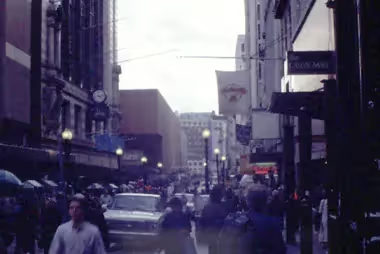A biweekly newsletter with public space news, resources, and opportunities.
A curated dispatch on all things public markets plus the latest announcements from the Market Cities Program.
Please note that these Hall of Shame nominations were written in a moment in time (most over a decade ago) and likely have since changed or even been transformed. If the above entry is now great, or still not so great, go ahead and comment below on how it has evolved or nominate it as a great place.
Remodeled in 1979 and again in 1983, the bricked pedestrian streets threading between major department stores are the site of a large-scale, long-running vending cart program.

Located at the hub of downtown Boston's retail and transit activity and covering several blocks radiating from a central "T" stop, Downtown Crossing has always been a popular location for department stores, specialty stores, and eateries. But when the streets were closed to vehicular traffic in the 1970s, much of the pedestrian traffic evaporated as well. To bring life back to the street, the Downtown Crossing Association was established in the early 1980s to manage a cart-vendor program that controls the image and viability of the vending carts.
Located in a heavily trafficked area downtown, near the Boston Common & Public Garden, with very good access on foot, by bus and subway. Auto access is limited at best.
A strong retail/commerce image provides a pleasant alternative to suburban-style malls. Downtown Crossing draws people based on this reputation even when it is not the cheapest or most convenient retail option. Comfort is good; people feel like this place is "real."
As a transit center, the area attracts pedestrians and commuters. As a retail center, it offers department stores, specialty shops, cafes, carts, etc. It is also a business/office center. As a social/recreation center, people come to Downtown Crossing on the weekends to shop, stroll, relax, and meet others.
This is a place to go with friends or family to enjoy being in a vibrant urban setting and either actively shop or simply watch the people go by. It's more formal than an open-air marketplace (and has less social activity than one), but still a place where people walk and talk. Some interaction between vendors and customers - especially tourists.
Washington Street has historically been downtown Boston's major thoroughfare; in the late 19th century, its commercial importance was undisputed. By the 1970s, the area was in decline, yet it was still a major commercial center. Auto traffic had increased, but at the expense of pedestrian space for shoppers, who kept Downtown Crossing's retail engine running. Following the success of nearby Fanueil Hall marketplace, the city initiated plans in 1977 to redevelop Downtown Crossing as a car-free marketplace, coinciding with major transit extensions intended to increase ridership and, hence, Downtown Crossing patronage.
In 1979, the new Downtown Crossing was unveiled. It boasted wide brick sidewalks, all sorts of pedestrian amenities, and no cars. However, even though a 1980 Project for Public Spaces survey found that area had become more vital and popular, it became apparent that removing cars and giving the entire street to pedestrians was not working as well as had been hoped (nor as well as at Fanueil Hall). With so much space, many areas were underused.
To maximize the use of Downtown Crossing's public spaces, PPS proposed rearranging amenities and developing a management program to sponsor activities in Downtown Crossing. The Downtown Crossing Association was formed to implement PPS' suggestions, and in 1983, the current Downtown Crossing Marketplace opened.
The Association established a partnership with a private operator to start and manage the vending program, thus avoiding expenses itself. The Association ensures that the 75 on-street vendors sell a wide variety of products, don't compete with existing stores, and are located strategically. For example, only one-quarter of the carts can sell food, and impulse-purchase products are located near entrances to the transit station. Strict guidelines control cart appearance, quality of merchandise, and return policies. Revenues are shared between the operator and the Association, and also go toward activities such as concerts.


*Please note that these Hall of Shame nominations were written in a moment in time (most over a decade ago) and likely have since changed or even been transformed. If the above entry is now great, or still not so great, go ahead and comment below on how it has evolved or nominate it as a great place.